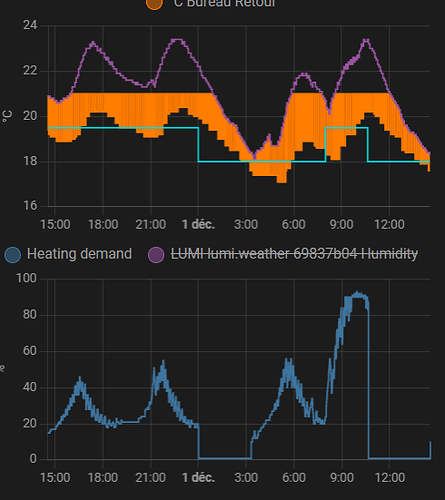Hey there,
I am receiving similar errors for 1 of my automations. I have in total 3 automations that feed external temp to 3 Danfoss TRV’s. Only one of the TRV’s fails to receive attribute set (totally at random).
Fails randomly both from automation and manual attempts:
service: zha.set_zigbee_cluster_attribute
data:
cluster_type: in
ieee: 34:10:f4:ff:fe:62:75:7f
endpoint_id: 1
cluster_id: 513
attribute: 16405
value: >-
{{ (states('sensor.zhimi_mb3_853f_temperature') |
float(state_attr('climate.danfoss_etrv0103_thermostat_2',
'current_temperature')) * 100) | round(0) }}
2024-06-09 12:00:05.172 ERROR (MainThread) [homeassistant.components.automation.aktualizuj_temperature_termostatu_2] Termostat Gabinet: Aktualizuj temperaturę: Error executing script. Error for call_service at pos 1: Failed to set attribute: value: 2440 attribute: 16405 cluster_id: 513 endpoint_id: 1
2024-06-09 12:00:05.173 ERROR (MainThread) [homeassistant.components.automation.aktualizuj_temperature_termostatu_2] Error while executing automation automation.aktualizuj_temperature_termostatu_2: Failed to set attribute: value: 2440 attribute: 16405 cluster_id: 513 endpoint_id: 1
2024-06-09 12:45:02.911 ERROR (MainThread) [homeassistant.helpers.script.websocket_api_script] websocket_api script: Error executing script. Error for call_service at pos 1: Failed to set attribute: value: 2440 attribute: 16405 cluster_id: 513 endpoint_id: 1
2024-06-09 12:45:02.913 ERROR (MainThread) [homeassistant.components.websocket_api.http.connection] [140632112369376] Error handling message: Failed to set attribute: value: 2440 attribute: 16405 cluster_id: 513 endpoint_id: 1 (home_assistant_error) Patryk from 172.16.16.4 (Mozilla/5.0 (Windows NT 10.0; Win64; x64) AppleWebKit/537.36 (KHTML, like Gecko) Chrome/125.0.0.0 Safari/537.36 Edg/125.0.0.0)
2024-06-09 12:48:17.548 ERROR (MainThread) [homeassistant.components.websocket_api.http.connection] [140632112369376] Error handling message: Unknown error (unknown_error) Patryk from 172.16.16.4 (Mozilla/5.0 (Windows NT 10.0; Win64; x64) AppleWebKit/537.36 (KHTML, like Gecko) Chrome/125.0.0.0 Safari/537.36 Edg/125.0.0.0)
Traceback (most recent call last):
File "/usr/src/homeassistant/homeassistant/components/websocket_api/decorators.py", line 27, in _handle_async_response
await func(hass, connection, msg)
File "/usr/src/homeassistant/homeassistant/components/zha/websocket_api.py", line 829, in websocket_read_zigbee_cluster_attributes
success, failure = await cluster.read_attributes(
^^^^^^^^^^^^^^^^^^^^^^^^^^^^^^
File "/usr/local/lib/python3.12/site-packages/zigpy/zcl/__init__.py", line 528, in read_attributes
result = await self.read_attributes_raw(to_read, manufacturer=manufacturer)
^^^^^^^^^^^^^^^^^^^^^^^^^^^^^^^^^^^^^^^^^^^^^^^^^^^^^^^^^^^^^^^^^^
File "/usr/local/lib/python3.12/site-packages/zigpy/quirks/__init__.py", line 268, in read_attributes_raw
return await super().read_attributes_raw(
^^^^^^^^^^^^^^^^^^^^^^^^^^^^^^^^^^
File "/usr/local/lib/python3.12/site-packages/zhaquirks/danfoss/thermostat.py", line 223, in _read_attributes
return await self.split_command(
^^^^^^^^^^^^^^^^^^^^^^^^^
File "/usr/local/lib/python3.12/site-packages/zhaquirks/danfoss/thermostat.py", line 210, in split_command
await func(records_standard, *args, **kwargs) if records_standard else []
^^^^^^^^^^^^^^^^^^^^^^^^^^^^^^^^^^^^^^^^^^^^^
File "/usr/local/lib/python3.12/site-packages/zigpy/quirks/__init__.py", line 334, in _read_attributes
return await super()._read_attributes(
^^^^^^^^^^^^^^^^^^^^^^^^^^^^^^^
File "/usr/local/lib/python3.12/site-packages/zigpy/zcl/__init__.py", line 377, in request
return await self._endpoint.request(
^^^^^^^^^^^^^^^^^^^^^^^^^^^^^
File "/usr/local/lib/python3.12/site-packages/zigpy/endpoint.py", line 265, in request
return await self.device.request(
^^^^^^^^^^^^^^^^^^^^^^^^^^
File "/usr/local/lib/python3.12/site-packages/zigpy/device.py", line 339, in request
await send_request()
File "/usr/local/lib/python3.12/site-packages/zigpy/application.py", line 841, in request
await self.send_packet(
File "/usr/local/lib/python3.12/site-packages/bellows/zigbee/application.py", line 931, in send_packet
raise zigpy.exceptions.DeliveryError(
zigpy.exceptions.DeliveryError: Failed to deliver message: <EmberStatus.DELIVERY_FAILED: 102>
2024-06-09 12:50:35.515 ERROR (MainThread) [homeassistant.components.websocket_api.http.connection] [140632112369376] Unexpected exception
Traceback (most recent call last):
File "/usr/src/homeassistant/homeassistant/components/zha/core/device.py", line 789, in write_zigbee_attribute
response = await cluster.write_attributes(
^^^^^^^^^^^^^^^^^^^^^^^^^^^^^^^
File "/usr/local/lib/python3.12/site-packages/zhaquirks/danfoss/thermostat.py", line 363, in write_attributes
write_res = await super().write_attributes(
^^^^^^^^^^^^^^^^^^^^^^^^^^^^^^^
File "/usr/local/lib/python3.12/site-packages/zigpy/zcl/__init__.py", line 626, in write_attributes
return await self.write_attributes_raw(attrs, manufacturer)
^^^^^^^^^^^^^^^^^^^^^^^^^^^^^^^^^^^^^^^^^^^^^^^^^^^^
File "/usr/local/lib/python3.12/site-packages/zigpy/zcl/__init__.py", line 632, in write_attributes_raw
result = await self._write_attributes(attrs, manufacturer=manufacturer)
^^^^^^^^^^^^^^^^^^^^^^^^^^^^^^^^^^^^^^^^^^^^^^^^^^^^^^^^^^^^^^
File "/usr/local/lib/python3.12/site-packages/zigpy/quirks/__init__.py", line 350, in _write_attributes
return await super()._write_attributes(
^^^^^^^^^^^^^^^^^^^^^^^^^^^^^^^^
File "/usr/local/lib/python3.12/site-packages/zigpy/zcl/__init__.py", line 377, in request
return await self._endpoint.request(
^^^^^^^^^^^^^^^^^^^^^^^^^^^^^
File "/usr/local/lib/python3.12/site-packages/zigpy/endpoint.py", line 265, in request
return await self.device.request(
^^^^^^^^^^^^^^^^^^^^^^^^^^
File "/usr/local/lib/python3.12/site-packages/zigpy/device.py", line 339, in request
await send_request()
File "/usr/local/lib/python3.12/site-packages/zigpy/application.py", line 841, in request
await self.send_packet(
File "/usr/local/lib/python3.12/site-packages/bellows/zigbee/application.py", line 931, in send_packet
raise zigpy.exceptions.DeliveryError(
zigpy.exceptions.DeliveryError: Failed to deliver message: <EmberStatus.DELIVERY_FAILED: 102>
The above exception was the direct cause of the following exception:
Traceback (most recent call last):
File "/usr/src/homeassistant/homeassistant/components/websocket_api/commands.py", line 241, in handle_call_service
response = await hass.services.async_call(
^^^^^^^^^^^^^^^^^^^^^^^^^^^^^^^
File "/usr/src/homeassistant/homeassistant/core.py", line 2741, in async_call
response_data = await coro
^^^^^^^^^^
File "/usr/src/homeassistant/homeassistant/core.py", line 2784, in _execute_service
return await target(service_call)
^^^^^^^^^^^^^^^^^^^^^^^^^^
File "/usr/src/homeassistant/homeassistant/helpers/service.py", line 1080, in _async_admin_handler
await result
File "/usr/src/homeassistant/homeassistant/components/zha/websocket_api.py", line 1305, in set_zigbee_cluster_attributes
response = await zha_device.write_zigbee_attribute(
^^^^^^^^^^^^^^^^^^^^^^^^^^^^^^^^^^^^^^^^
File "/usr/src/homeassistant/homeassistant/components/zha/core/device.py", line 793, in write_zigbee_attribute
raise HomeAssistantError(
homeassistant.exceptions.HomeAssistantError: Failed to set attribute: value: 2450 attribute: 16405 cluster_id: 513 endpoint_id: 1
TRV itself seems to work just fine, except of this external data feed problem.
2 remaining TRVs (same model, same firmware) do not report such problems.



